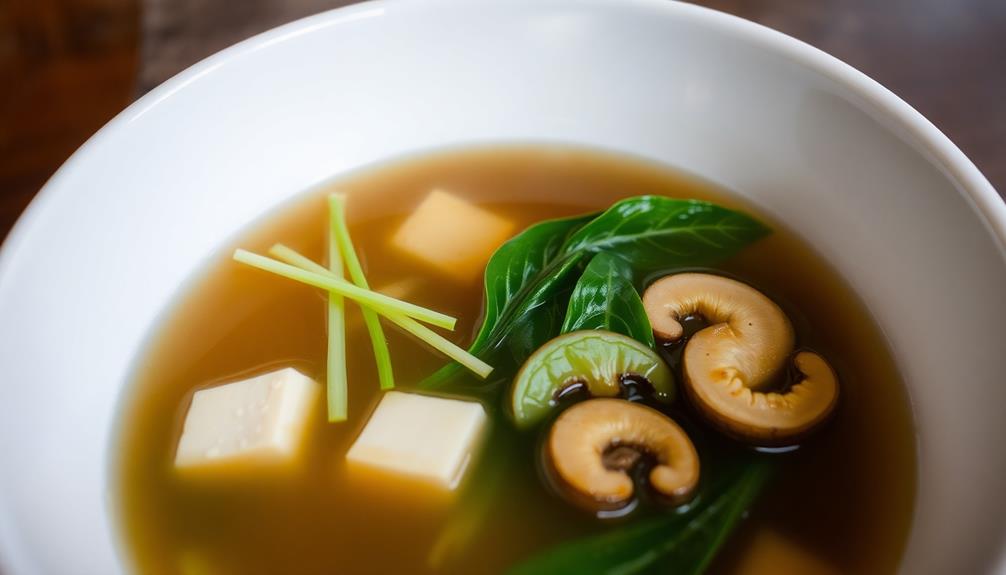You've probably heard of miso soup before, but do you really know what makes it such a beloved dish? From its rich history to its surprising health benefits, there's more to this simple Japanese staple than meets the eye. Whether you're a longtime fan or new to the world of miso, delving into its origins and preparation can reveal just why it's become a culinary cornerstone across the globe. So, let's dive in and uncover the secrets behind this comforting and flavorful soup.
Key Takeaways
- Miso soup is a traditional Japanese comfort food made with fermented soybean paste (miso) and dashi broth as the base.
- The soup can be customized with various ingredients like tofu, green onions, and shiitake mushrooms, as well as optional additions like spinach or wakame seaweed.
- Preparing miso soup involves warming the dashi broth, adding miso paste, incorporating ingredients, and simmering briefly to allow flavors to meld.
- The type of miso paste used affects the overall flavor profile of the soup, with different varieties offering distinct umami characteristics.
- Miso soup is versatile and can be served as a starter, accompaniment, or main course, providing numerous health benefits and opportunities for personalization.
History
Miso soup's origins can be traced back to ancient China, where fermented soybean paste was used in various culinary preparations. This savory, umami-rich broth later made its way to Japan, where it became an integral part of the country's traditional cuisine.
Over the centuries, Japanese chefs have developed a wide range of miso varieties, each with its unique flavor profile, ranging from sweet and mild to bold and salty.
The process of making miso is a true art form, involving the fermentation of soybeans, grains, and a special mold called koji. The mixture is then aged for months or even years, allowing the flavors to meld and intensify.
Today, miso isn't only a staple in Japanese households but also a beloved ingredient in many international cuisines, adding depth and complexity to soups, stews, and marinades.
Recipe
Miso soup is a traditional Japanese dish that has become a beloved comfort food worldwide. Its savory, umami-rich broth and simple, yet flavorful ingredients make it a versatile and satisfying meal.
Miso, a fermented paste made from soybeans, is the key to unlocking the distinctive flavor of this soup. The miso is dissolved in a hot dashi broth, creating a complex and nourishing base that can be customized with various additions. To elevate the umami flavor of the miso soup, ingredients such as tofu, seaweed, and scallions can be added. Additionally, for a touch of sweetness, try incorporating the sweet dumplings recipe, which consists of a delicate combination of glutinous rice flour and a sweet filling such as red bean paste. These additions not only enhance the flavor of the miso soup but also add different textures and layers to the dish.
Ingredients:
- 4 cups dashi broth
- 2 tablespoons white or yellow miso paste
- 1/2 cup cubed tofu
- 2 green onions, sliced
- 1/2 cup shiitake mushrooms, sliced
- 1/2 cup spinach or wakame seaweed (optional)
Instructions:
Bring the dashi broth to a gentle simmer in a saucepan. Gradually whisk in the miso paste until fully dissolved. Add the tofu, green onions, and mushrooms, and continue to simmer for 2-3 minutes, or until the vegetables are tender.
If using spinach or wakame, add them during the last minute of cooking to prevent overcooking.
When preparing miso soup, it's important to avoid boiling the miso, as this can cause the delicate flavors to be lost. Additionally, the type of miso used can significantly impact the overall taste, so experiment with different varieties to find your preferred flavor profile.
Cooking Steps
First, you'll want to warm up the dashi broth on the stove.
Then, add the other ingredients like tofu, seaweed, and green onions.
Step 1. Warm the Dashi Broth

The pot simmers as you pour in the dashi broth, its earthy aroma rising to awaken your senses. Dashi, the savory Japanese stock, forms the backbone of miso soup.
Bring the broth to a gentle simmer over medium heat, allowing the flavors to meld. As the liquid heats, carefully slice the tofu into bite-sized cubes, ensuring a uniform texture. Add the tofu to the simmering broth, letting it warm through without boiling.
Next, prepare the miso paste. Using a small amount of the hot broth, whisk the miso until it dissolves completely, creating a smooth, creamy consistency.
Gently stir the miso mixture back into the pot, taking care not to overheat and alter the delicate flavor. Adjust the heat to maintain a gentle simmer, allowing the miso to infuse the broth with its umami richness.
Step 2. Add Ingredients

With the dashi broth simmering and the tofu cubed, it's time to add the remaining ingredients.
First, grab your miso paste. Scoop out a few tablespoons and whisk it into the broth until it's fully dissolved. This will give your soup that classic miso flavor.
Next, it's time to add the veggies. Slice up some green onions, cutting them on the diagonal for a nice presentation. Toss those in along with some sliced mushrooms.
If you have any other veggies you'd like to include, like spinach or cabbage, go ahead and add them now.
Finally, gently lower the cubed tofu into the broth. Be careful not to break it up too much. Let the soup simmer for a couple more minutes to allow all the flavors to meld together.
And there you have it! Your miso soup is now ready to serve. Ladle it into bowls and enjoy the warm, savory goodness.
Step 3. Add Miso Paste

Introducing the miso paste is a crucial step in crafting the soup's signature flavor. This fermented soybean paste adds a savory, umami-rich depth that's simply irresistible.
Gently drop a few spoonfuls of the miso into the simmering broth, stirring continuously to dissolve it evenly. Be mindful not to boil the miso, as that can diminish its flavor.
The type of miso you choose can significantly impact the final taste. White or yellow miso lends a milder, sweeter note, while red miso brings a more robust, salty punch.
Experiment to find your perfect miso match! Once the miso has blended seamlessly into the broth, give it a taste and adjust the seasoning as needed. The miso should provide a harmonious balance, neither overpowering nor underwhelming.
With the miso incorporated, your miso soup is well on its way to becoming a comforting, flavor-packed delight.
Savor each sip and enjoy the depth of umami goodness.
Step 4. Simmer the Soup Briefly

Once the miso has been added, let the soup simmer gently for just a few minutes. This brief simmering allows the flavors to meld and the miso to fully dissolve.
You don't want to overdo it, as prolonged simmering can dull the fresh, savory taste of the miso.
Keep the heat at medium-low, and let the soup gently bubble away for 2-3 minutes. Stir occasionally to ensure even heating.
You'll know it's ready when the soup has a rich, velvety texture and the miso has completely incorporated.
Be careful not to let the soup boil vigorously, as this can cause the delicate miso to become bitter. The goal is a softly simmering, harmonious broth that showcases the miso's umami goodness.
Once the brief simmer is complete, your miso soup is ready to serve and enjoy! The light, comforting flavors will warm you from the inside out.
Step 5. Serve Immediately in Bowls

After the miso has melded with the broth, ladle the fragrant miso soup into individual serving bowls.
Ensure to distribute the silky, umami-rich liquid evenly, allowing each bowl to brim with the aromatic goodness. Garnish the soup with any desired toppings, such as thinly sliced scallions, a sprinkle of toasted sesame seeds, or a drizzle of chili oil.
Serve the miso soup immediately while it's piping hot, allowing the warmth to envelop your senses.
Encourage your guests to savor each sip, appreciating the depth of flavor that the miso brings to the dish. The combination of the savory broth and the salty, fermented paste creates a harmonious balance that's both comforting and invigorating.
Final Thoughts
Miso soup's versatility and health benefits make it a fantastic choice for any meal.
Whether you're looking for a light starter, a comforting accompaniment, or a nourishing main course, this umami-rich broth can do it all. The options are endless when it comes to customizing your miso soup with a variety of toppings and additional ingredients.
As you've learned, the key to a truly delectable miso soup is in the preparation. By following the simple steps outlined in this article, you'll be able to craft a restaurant-quality dish in the comfort of your own home.
Don't be afraid to experiment and find the flavor combinations that suit your personal taste. The beauty of miso soup is that it can be adapted to fit any mood or occasion.










